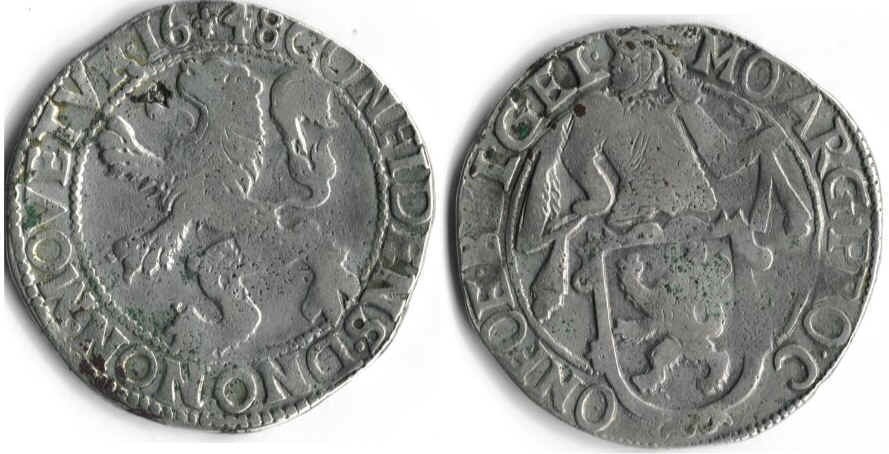

| Type munt | Leeuwendaalder | Omschrift voorzijde | MO.ARG.PRO.C(O) (N).F(OE).BEL(G).GEL | Muntconditie | zeer fraai min |
| Provincie | Gelderland | Omschrift keerzijde | CONFIDENS.DNO. NON.MOVETVR | Datum | 18 april 2004 |
| Muntplaats | Voorzijde | ridder naar links (!), met wapen | Verkoper | stanleyke | |
| Jaartal | 1648 | Keerzijde | klimmende leeuw naar links | Bedrag | EUR 61,00 |
| Vorst | Vindplaats | Veiling | ebay | ||
| Metaal | Zilver, 0,750 (opgave Zonnebloem) | Schatvondst | |||
| Oplage | Literatuur referentie | Delm 825, V11-1 | |||
| Gewicht | 26,8 gram (opgave handelaar) normaal 27,68 gram (opgave Zonnebloem) | ||||
| Diameter | 42 mm (opgave handelaar) | ||||
| Soortelijke massa |
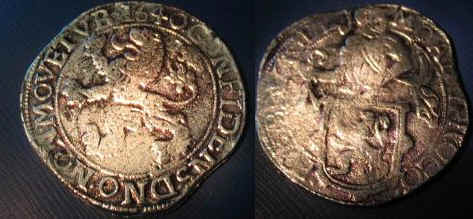 "The lion dollar circulated throughout the Middle East and was imitated in several German and Italian cities. It was also popular in the Dutch East Indies as well as in the Dutch New Netherlands Colony (New York). The lion dollar also circulated throughout the English colonies during the Seventeenth and early Eighteenth centuries. Examples circulating in the colonies were usually fairly well worn so that the design was not fully distinguishable, thus they were sometimes referred to as "dog dollars." Larger Dutch silver coins as the ducatoon and the "rix" dollar (rijksdaalder) were also used in the colonies but neither of these coins had such a wide circulation or long lasting influence as the lion dollar. In Maryland the lion dollar was mentioned as the most important circulating coin in documents of 1701 and 1708, with its value stated as 4s6d. It is reported by Felt (p. 250) that a deposition was taken in Boston on July 29, 1701 stating that "Dog or Lion dollars" had been counterfeited in Massachusetts. In 1708 the New York Assembly set the value of the lion dollar at 5s6d. Also, the New York paper currency emission of November 1, 1709 was issued as amounts of sterling silver expressed in denominations of 4, 8, 16 and 20 lion dollars, with 13.75 oz. of silver equal to 20 lion dollars. Mossman also states lion dollars were used in Pennsylvania, New Jersey and Virginia. In April of 1998 a Mike Cato from Virginia sent me an e-mail that he had discovered a 1640 lion dollar while metal detecting. In the hoard collected from the H.M.S. Feversham, which sank on October 7, 1711 after leaving New York, there were 22 lion dollars (quantitatively third only to the 504 Spanish Colonial silver coins and the 126 specimens of Massachusetts silver). Also, two lion dollars were inventoried in the hoard discovered in Castine, Maine, thought to have been deposited there in 1704 by French colonists fleeing from the English. It should be recalled that most of the Castine hoard was dispersed before an inventory could be produced. Lion dollars were no longer minted after 1713, during the Eighteenth century they were replaced in the Mideast by the Austrian thaler. In the English colonies New World Spanish silver had always held first place and with the advent of the famous milled silver coinage in 1732, the Spanish milled dollar absorbed the lion dollar's share of the market.(End of his desciption) I found this coin myself whilst diving off the northeast coast of the united states about 8 years ago. Aside from showing it to company as a conversation piece." |
US $52,56 (Ongeveer EUR 39,02), 03-jan-05, jskinner84t, ebay. |
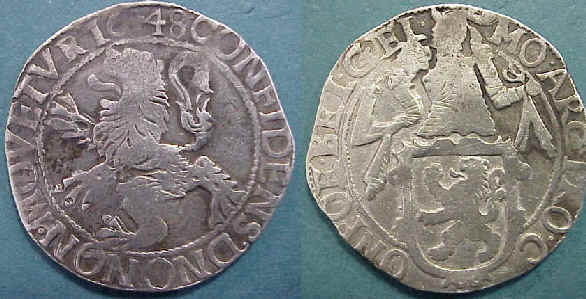 |
US $53,33 (Ongeveer EUR 39,59), ebay, 02-jan-05, tagishbridge |
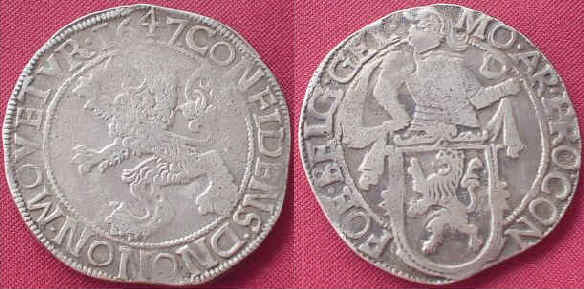 |
OBVERSE : Armored knight looking left above lion shield in circle. Legend
: MO.AR.PRO.CON.FOE.BELG.GEL. REVERSE : Rampant lion left, date at top in legend. Legend : CONFIDENS.DNONON.MOVETVR.1647. Weight 26.93 gr US $82,00 (EUR 63,45), 16-feb-05, ebay, javaman691 |
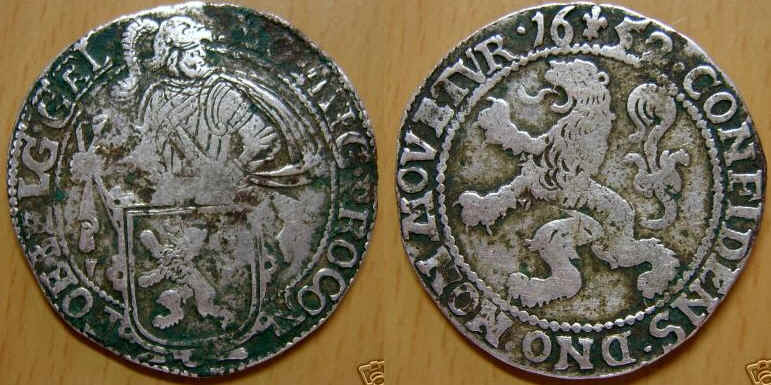 |
DIAMETER : 41 MM WEIGHT : 30 GRAMS US $61,00 (EUR 49,98) 30-jul-05, ebay, exellcoins1 |
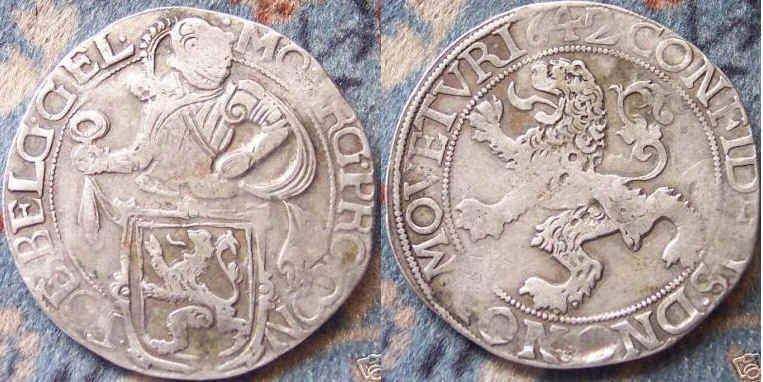 |
1642 US $104,26 (EUR 83,52), 22-aug-05, ebay, dennyscoins |
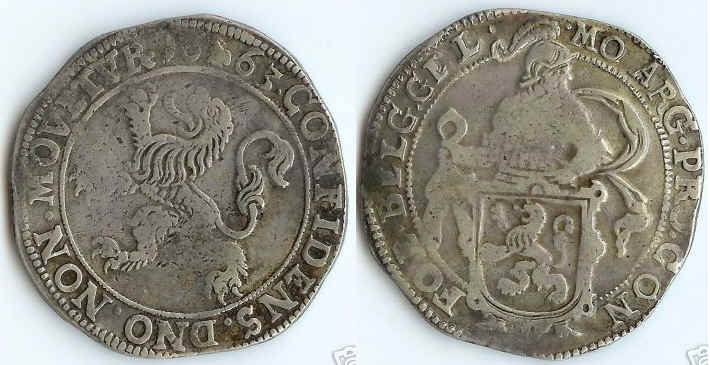 |
Gelderland Leeuwendaalder 1663, 42 mm. Delmonte 825 R3 EUR 80,00 niet verkocht, 28-nov-05, ebay, peter290371 |
 |
Löwentaler - GELDERN Leeuwendaaler Vs: geharnischter Ritter mit wehendem Mantel und Provinzschild Rs: aufrechter heraldischer Löwe der Löwentaler wurde seit 1575 von den unabhängigen Niederlanden geprägt; zuerst für den Umlauf in den Niederlanden, aber bald schon nur noch für den Handel mit Ostsee- und Balkanländern und für den Levantehandel(Asien). Die Währungen von Bulgarien (Lewa) und Rumänien (Leu) wurden von diesem Taler abgeleitet. Gewicht: ca. 25 Gramm - Durchm.: ca. 40 mm EUR 41,72, 26-mrt-06, ebay, uiop50 |
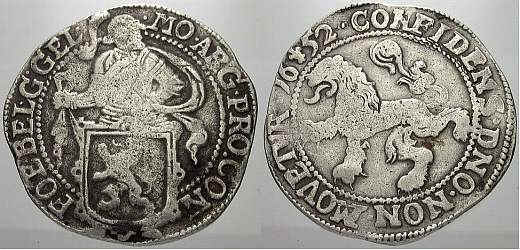 |
Lion Silver Dollar - Gelderland. 1652 AD. 42 mm. 26.4 gr. Obverse: MO ARG PRO CON FOE BELG GEL. Reverse: CONFIDENS DNO NON MOVETVR 1652. US $76,00 (EUR 60,37), 01-mei-06, ebay, silenoscoins |